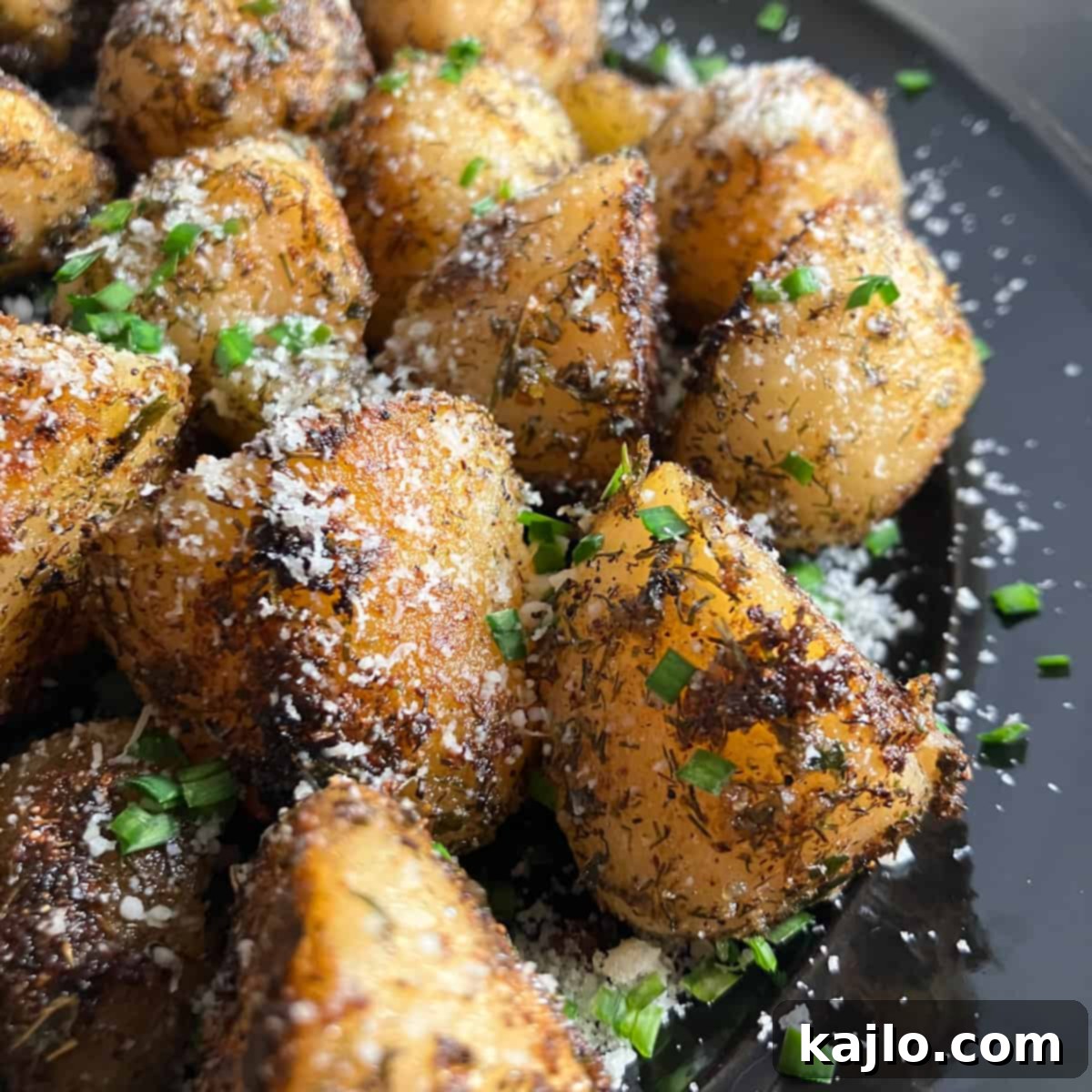Unlocking the Potential of Canned Potatoes: Your Ultimate Guide to Delicious and Easy Meals
Discover the incredible versatility and convenience of canned potatoes. Far from being just a pantry staple, these humble spuds offer a quick, affordable, and delicious way to incorporate more vegetables into your diet. Whether you have canned whole potatoes or canned sliced potatoes, this comprehensive guide will show you the best way to cook canned potatoes, transform them into mouth-watering dishes, and effortlessly integrate them into your favorite recipes. Say goodbye to the hassle of peeling and boiling fresh potatoes and embrace the ease of canned varieties for flavorful, time-saving meals.

“These are absolutely DELICIOUS. I doubled the batch and it still was all eaten!”
– Tiffani, a satisfied home cook
Cans of potatoes have become a secret weapon in my kitchen, quickly rising to the top of my favorite canned vegetables list. Their extended shelf life makes them a godsend for busy individuals, small households, or anyone looking to minimize food waste, especially compared to fresh potatoes that can spoil quickly. This makes them an excellent item to stock up on, ensuring you always have a nutritious side dish or recipe base readily available – perfect for last-minute meals or even emergencies.
Beyond their impressive longevity, canned potatoes are also fantastic for portion control. Each can typically provides 1-2 sensible servings, helping you manage meal sizes without extra effort. This convenience factor, combined with their readiness for immediate use, significantly cuts down on prep time, making healthy eating more accessible than ever.
Today, we’re diving into how to create perfectly golden, crispy-edged fried potatoes using these brilliant pantry items. The result? Pan-fried potatoes so delectable, no one will ever suspect you took a clever shortcut by using potatoes from a can. You can opt for popular brands like Del Monte canned potatoes, or choose store brands from retailers like Aldi or Walmart. For those who enjoy home canning, your pressure-canned potatoes will work beautifully too!
While we’ll focus on fried and roasted methods, don’t limit yourself! Canned potatoes are incredibly versatile. They can be mashed, used in potato salad, added to soups, or incorporated into casseroles. Below, you’ll find a wealth of ideas to ensure you never get bored with this indispensable pantry staple.
🥘 Understanding Canned Potato Ingredients
When you pick up a can of potatoes, you’ll typically find a straightforward list of ingredients:
- Potatoes: These are usually peeled new potatoes, chosen for their smaller size to fit conveniently into cans.
- Water: The liquid medium in which the potatoes are preserved.
- Salt: Added for flavor and as a preservative. Note that most canned potatoes contain a significant amount of sodium, which you can reduce by rinsing.
- Calcium chloride: A firming agent used to help the potatoes maintain their texture during the canning process.
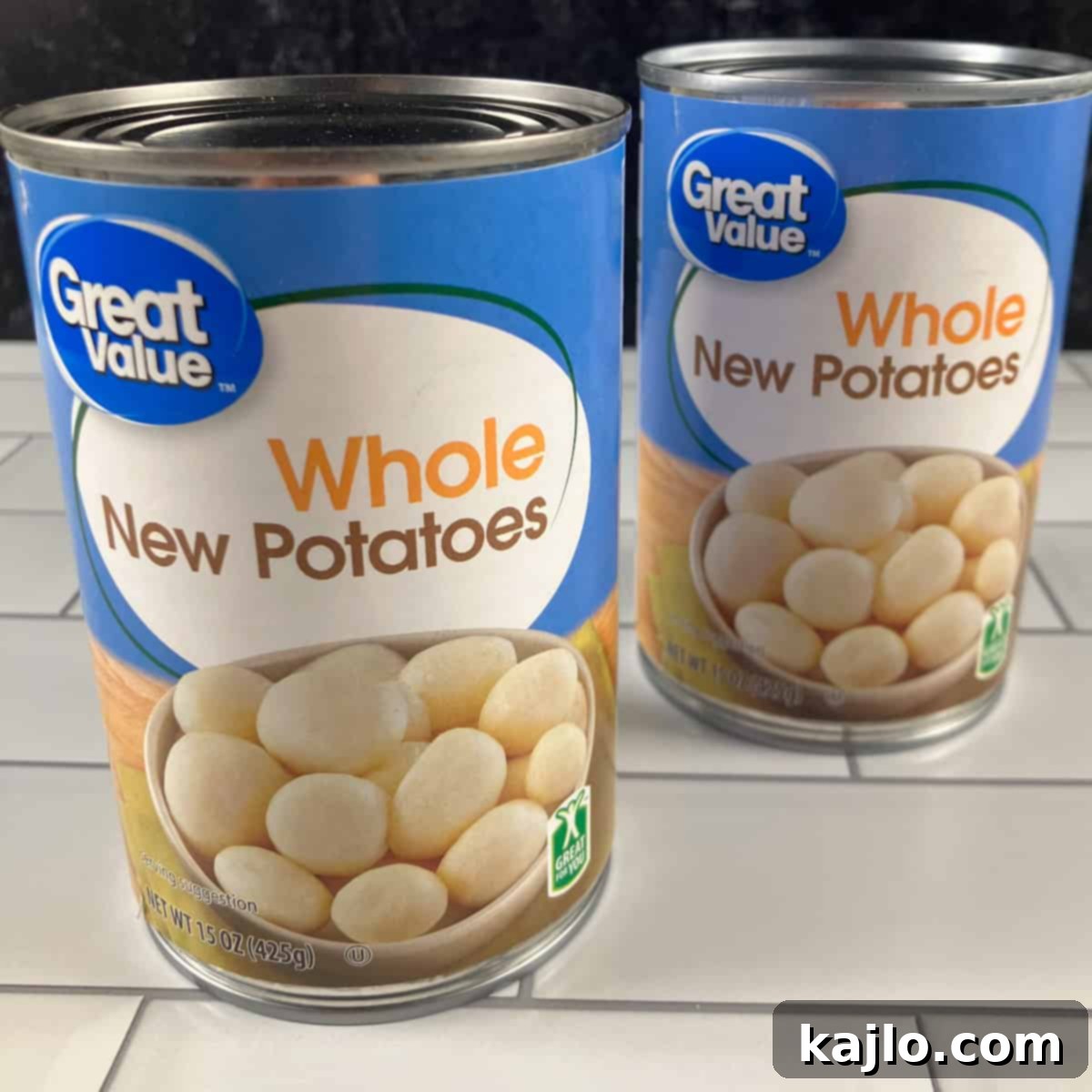
Enhancing Flavor: Seasoning is Key!
Because potatoes in a can tend to be quite bland, even more so than fresh potatoes, generous seasoning is absolutely essential to elevate their flavor. The possibilities are endless, allowing you to tailor them to any cuisine or personal preference. Consider popular blends like Italian seasoning, a zesty Cajun spice mix, or a bright lemon zest. Ranch dressing mix can also add a delightful savory kick. For a balanced, aromatic seasoning blend, I highly recommend this combination:
- Garlic powder
- Onion powder
- Dill weed
- Dried parsley
- Black pepper
After cooking, I love to enrich my potatoes with a knob of butter and a sprinkle of Parmesan cheese and fresh chives. A dollop of sour cream also makes a fantastic addition, adding a creamy tang that complements the savory herbs beautifully. Keep in mind that most canned potatoes already contain a fair amount of salt, so I typically find it unnecessary to add more. Always taste first!
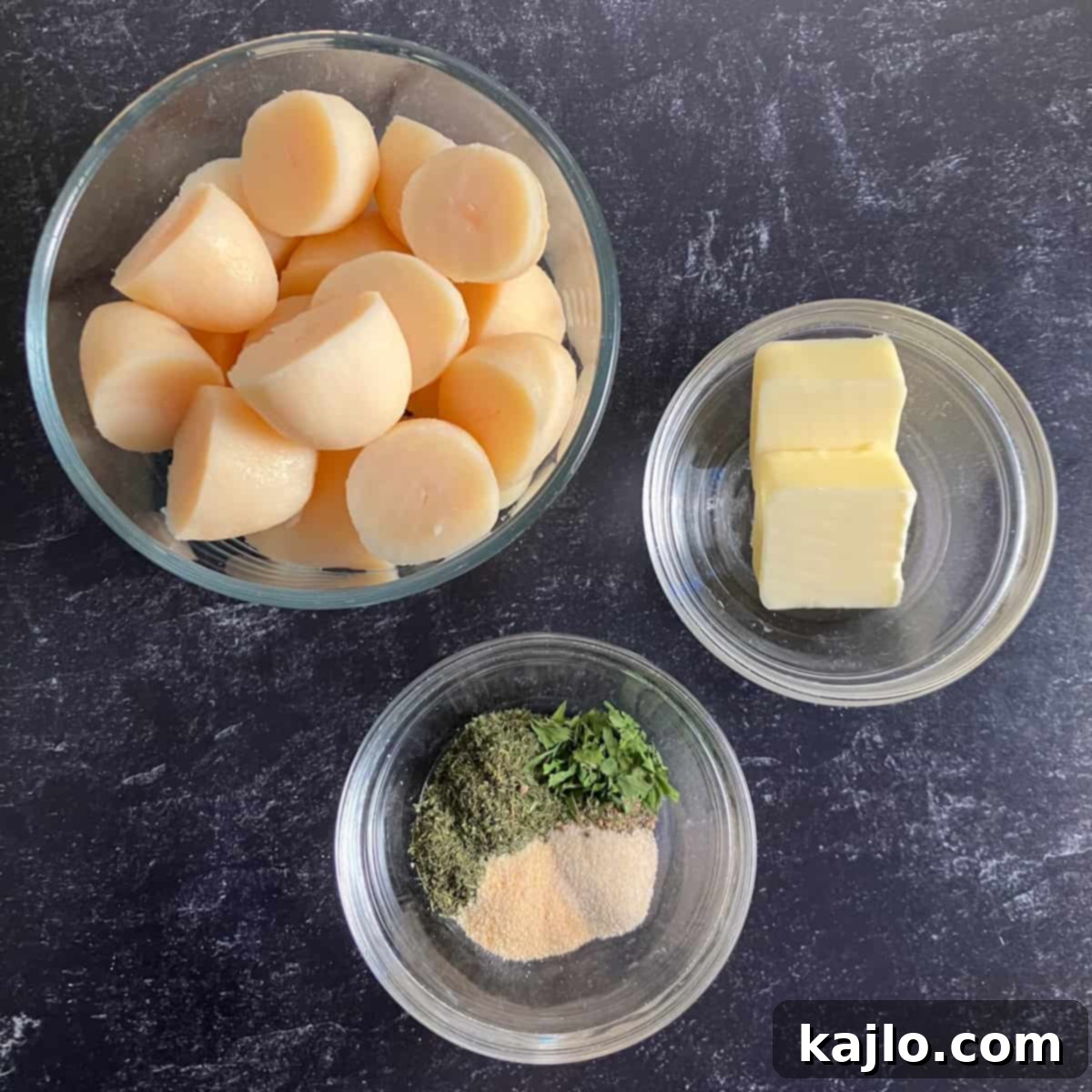
❓️ Are Canned Potatoes Already Cooked?
Yes, canned potatoes are indeed fully cooked and ready to eat straight from the can. They are typically peeled new potatoes, chosen for their small size and tender texture. If larger potatoes were used, only one or two would fit into a single can! While they are safe to consume without further cooking, heating them through and adding seasonings vastly improves their taste and texture, transforming them into a much more enjoyable dish.
🔥 Mastering the Art: How to Cook Canned Potatoes
Stovetop Method: Achieving Crispy Perfection
Step 1: Prepare the Potatoes
Begin by draining the canned potatoes thoroughly. If you’re mindful of sodium intake, I highly recommend rinsing them well under cold water. Pat them completely dry with paper towels – this crucial step helps achieve that desirable crispy exterior. Once dry, cut each potato in half to create more surface area for browning and to ensure even cooking.
Step 2: Season and Sauté
Melt two tablespoons of butter (or your preferred cooking oil like olive oil or avocado oil) in a cast-iron skillet over medium heat. Once the butter is melted and shimmering, add the halved potatoes along with your chosen seasonings: garlic powder, onion powder, dill, parsley, and black pepper. Stir gently to ensure all the potatoes are evenly coated with the butter and spices, setting the stage for rich flavor and uniform browning.

Step 3: Fry to Golden Perfection
Cook the potatoes for 10-12 minutes over medium heat, stirring and flipping them occasionally to achieve even browning on all sides. Watch for those beautiful golden-brown, crispy edges! If the potatoes appear to be getting too dry or starting to stick, you can add a tablespoon or two of water or a bit more butter to the pan. However, with enough butter, this step is usually unnecessary. Adjust heat as needed to prevent burning while ensuring a good crisp.
Expert Tip on Skillet Choice: While a cast-iron skillet is excellent for achieving superior browning and crispiness due to its even heat distribution, a regular skillet can also work. Just be aware that cooking times might be slightly longer, and a non-stick pan will prevent sticking. The butter or oil not only adds flavor but is key to developing that sought-after crust and preventing adhesion to the pan. For a lower-fat option, you could lightly steam the potatoes until heated through, then toss them with seasonings immediately after cooking.

Step 4: Garnish and Serve
Once the potatoes are cooked to your liking – tender on the inside and crispy on the outside – remove them from the heat. Sprinkle generously with grated Parmesan cheese and freshly chopped chives. Serve immediately as a delicious side dish. It’s that simple to transform humble canned potatoes into a truly satisfying meal!
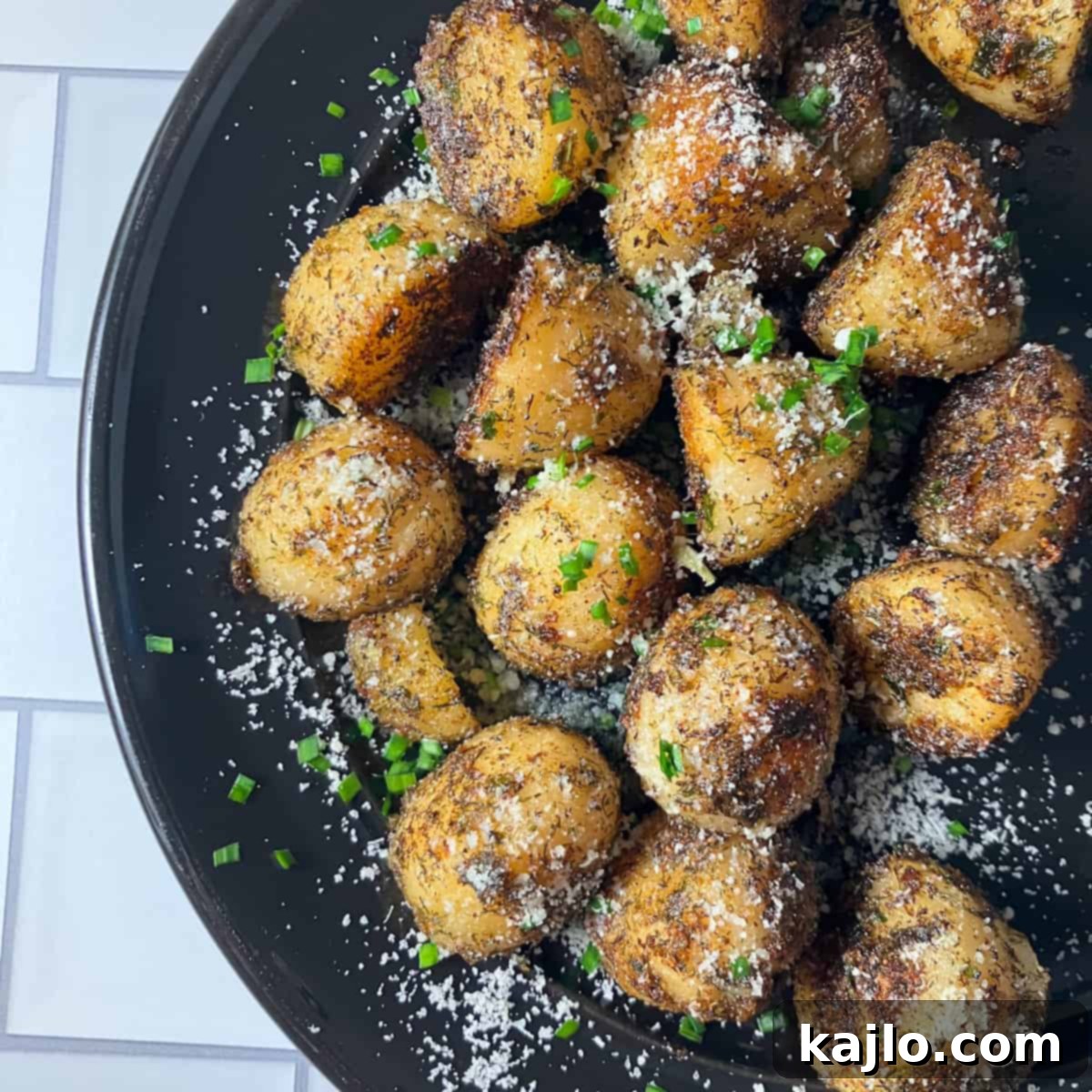
⏲ How to Cook Canned Potatoes in the Oven
Baking for a Hands-Off Approach
Step 1: Prep the Oven and Potatoes
Preheat your oven to 350°F (177°C). Line a dark cookie sheet with aluminum foil for easier cleanup and to help with browning. As with the stovetop method, drain and thoroughly rinse the canned potatoes, then pat them completely dry with paper towels. Dry potatoes are key to achieving a crispy texture in the oven.
Step 2: Season and Toss
Cut the potatoes in half and transfer them to a mixing bowl. Drizzle them with melted butter (or olive oil for a different flavor profile) and sprinkle generously with your chosen dried herbs and spices. Toss everything together until the potatoes are uniformly coated. Ensure every piece has a good layer of seasoning for maximum flavor.
Step 3: Bake to Crispy Goodness
Spread the seasoned potatoes in a single layer on the prepared foil-lined tray. Avoid overcrowding the tray, as this can steam the potatoes instead of roasting them, hindering crispiness. Bake for 30-40 minutes, flipping the potatoes halfway through the cooking time to ensure even browning. For best results, place the rack about ⅓ of the way down from the top of the oven.
Step 4: Final Touches
Once the potatoes are beautifully golden brown and crispy, remove them from the oven. Finish them off with a sprinkle of grated Parmesan and freshly chopped chives before serving. Enjoy these delightful oven-baked canned potatoes as a simple yet satisfying side dish.
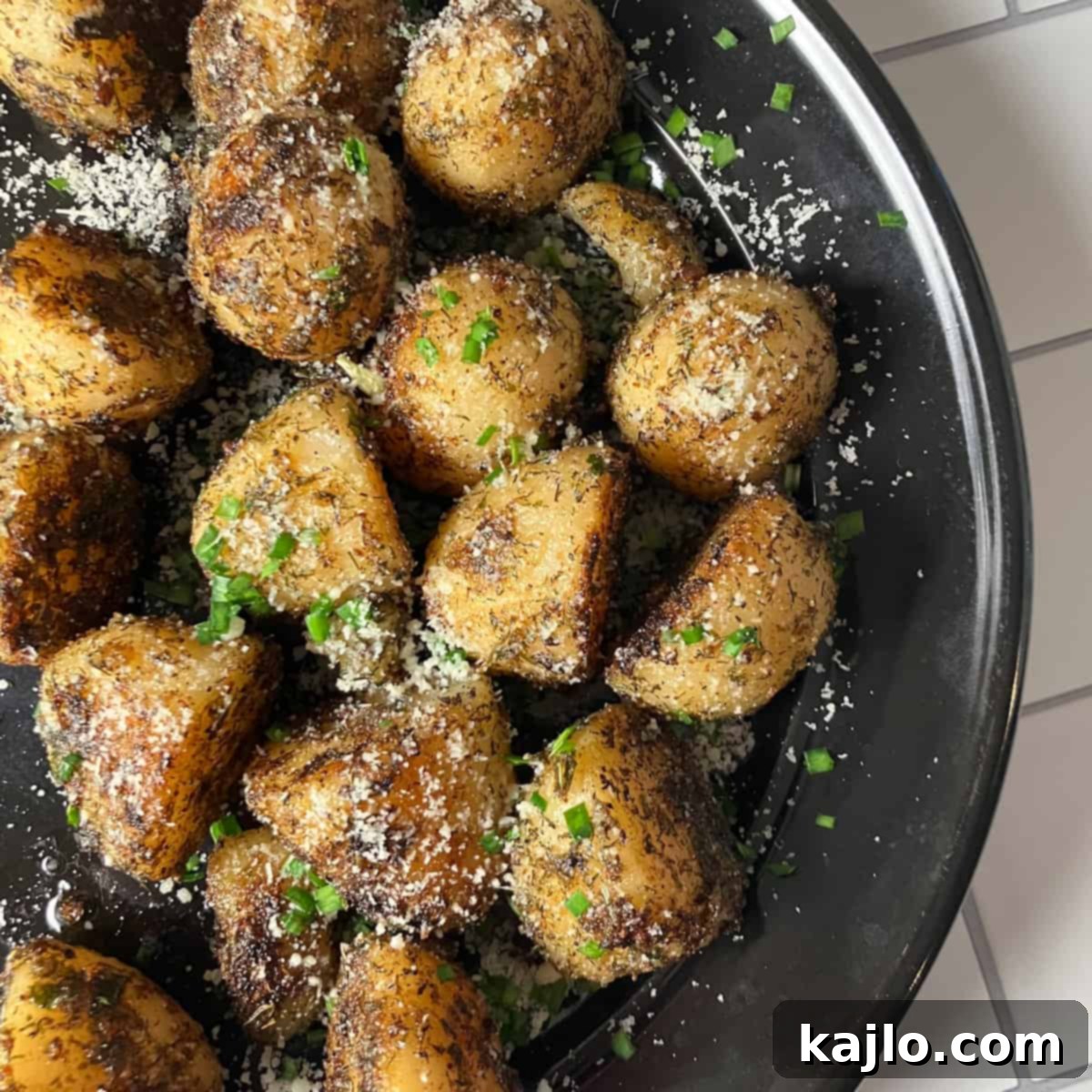
⭐ Stovetop vs. Oven: What’s the Best Way to Cook Canned Potatoes?
In my opinion, the stovetop method reigns supreme for cooking canned potatoes. It’s significantly faster than baking in the oven, and using a cast-iron pan makes it incredibly easy to achieve fantastic browning and a desirable crispy exterior. While both methods yield delicious results, the stovetop offers a quick and satisfying solution for busy weeknights.
🌡️ Storing Cooked and Unopened Canned Potatoes
Proper storage is essential to maintain the quality and safety of your potatoes. Cooked potatoes and open cans of potatoes should always be kept in the fridge, stored in covered, food-safe containers, and consumed within 3-4 days.
I generally do not recommend freezing cooked potatoes, especially roasted ones. The texture often changes significantly when frozen and then thawed, becoming mushy or mealy, which can detract from the eating experience.
However, unopened cans of potatoes are a non-perishable marvel! When stored in a cool, dry place in your pantry, they can maintain excellent quality for 2-5 years, making them an ideal item for long-term food storage. Always check the “best by” date on the can for optimal freshness, but rest assured, they often remain safe to eat well beyond that date (USDA guidelines).
😋 What to Serve with Canned New Potatoes
These flavorful, roasted canned potatoes make a fantastic side dish for almost any meal, especially a hearty roast dinner. Pair them with other vegetables and a protein for a balanced and satisfying plate. Here are some delicious ideas for what goes perfectly with canned potatoes:
- Crispy Air Fryer Frozen Green Beans
- Juicy Ninja Foodi Whole Chicken
- Sweet Air Fryer Baby Carrots
- Grilled Salmon or Steak
- Pan-seared Pork Chops
- Vegetarian Loaf or Lentil Patties
- A Fresh Green Salad with Vinaigrette
🥔 Creative Canned Potato Recipes & Uses
Beyond simple frying or roasting, tinned potatoes are incredibly versatile and can be used in almost any recipe that calls for cooked and peeled potatoes. Don’t be afraid to experiment! Here are some creative and delicious ideas for recipes using canned potatoes:
- Potato Salad: Their soft texture makes them ideal for a quick and easy potato salad. Simply drain, chop, and mix with your favorite dressing and add-ins.
- Potato Soup or Chowder: Canned potatoes are excellent for adding body and heartiness to creamy soups or robust chowders. No need for pre-cooking!
- Casseroles: Layer them into comforting casseroles, such as a hearty breakfast casserole or this unique baked canned sardines recipe, for a quick and easy base.
- Mashed Potatoes: Simply drain, mash with butter, milk, and your preferred seasonings for instant mashed potatoes. Top with gravy for the ultimate comfort food.
- Pot Pies or Shepherd’s Pie: Add them to the filling of a savory pot pie or use them as a convenient topping for a classic shepherd’s pie.
- Potato Hash: Cube them and pan-fry with onions, peppers, and your favorite breakfast meats for a quick and satisfying hash.
- Au Gratin or Scalloped Potatoes: Slice them thinly (if using whole canned potatoes) and layer with cheese sauce for a delicious, expedited au gratin.
You can also find sweet potatoes from a can, which offer a fantastic shortcut for making sweet potato casseroles or quick purees!
📋 Canned Potatoes Nutrition Facts
Are tinned potatoes a healthy option? Potatoes are naturally nutritious, and canned versions still retain many benefits. Here’s a general overview of the nutrition facts for one standard 15-ounce can of potatoes:
- Calories: Approximately 160 calories (for the potatoes alone, before added fats)
- Total Fat: 0.5g (naturally low in fat)
- Saturated Fat: 0g
- Trans Fat: 0g
- Cholesterol: 0mg
- Sodium: 720mg (31% Daily Value) – This can be significantly reduced by rinsing the potatoes before use.
- Total Carbohydrate: 35g
- Fiber: 6g (a good source of dietary fiber, promoting digestive health)
- Total Sugars: 2g
- Added Sugars: 0g
- Protein: 4g
- Iron: 15% Daily Value (contributes to oxygen transport in the body)
- Calcium: 2% Daily Value
- Potassium: 15% Daily Value (important for blood pressure and muscle function)
Potatoes are a highly nutritious starchy vegetable, naturally rich in fiber, iron, and potassium. However, they are not a complete source of nutrition; for instance, they typically don’t provide significant amounts of vitamin A. It’s also worth noting that potatoes lose a significant amount of their naturally occurring vitamin C content during the cooking and canning processes. Therefore, while canned potatoes are a great component of a meal, they should be part of a diverse diet.
Eating a wide variety of foods from different food groups, including both raw and cooked options, is the best way to ensure you’re getting all the essential nutrients your body needs for optimal health.
Nutrition Info Disclaimer
All recipes and nutrition information on this website may or may not be appropriate for you, depending on your individual medical needs and personal preferences. Please consult with a registered dietitian or your physician if you require personalized dietary advice.
The nutrition information provided is an estimate and offered as a courtesy. It will vary depending on the specific brands and ingredients you choose to use. Calorie information on food labels can sometimes be inaccurate, so we encourage you not to obsess over the exact numbers.
“To taste” in a recipe refers to adjusting seasonings to your personal preference, though visual cues may be necessary to adhere to food safety guidelines. Please ensure all foods are cooked to a safe internal temperature.
FAQs: Your Questions About Canned Potatoes Answered
How do I make canned potatoes crispy?
Achieving crispy canned potatoes is all about preparation and proper cooking technique. First, ensure the potatoes are completely dry after draining and rinsing them. Moisture is the enemy of crispiness. Next, coat them thoroughly in a good fat or oil, such as butter, olive oil, or avocado oil, which aids in browning. Finally, whether pan-frying or oven-roasting, make sure you cook them long enough. Don’t be afraid to add a little extra cooking time, flipping occasionally, until they reach your desired level of golden-brown crispness.
How do I cook canned sliced potatoes?
Cooking canned sliced potatoes is very similar to cooking whole or halved ones. You can use either the stovetop or oven method described above. Since sliced potatoes have more exposed surface area, they might require an extra tablespoon of butter or oil to prevent sticking and ensure even crisping. They are particularly excellent for dishes like easy potato gratins or quick skillet fries. Just ensure they are well-dried before cooking to get the best texture.
Can you eat raw potatoes?
While you can technically eat raw potatoes, it’s generally not recommended. They have an unpleasant starchy taste and can often cause gastrointestinal distress, including bloating and gas, due to their raw starches and certain compounds. Potatoes naturally contain glycoalkaloids (natural toxins like solanine and chaconine), which are not entirely eliminated by cooking but are reduced. Peeling raw potatoes before cooking can help further reduce their glycoalkaloid content. It’s always best to cook potatoes to make them more palatable and digestible.
Can you eat sprouted potatoes?
The Poison Control Center advises against eating potatoes that have sprouted. Sprouts are an indication that the potato’s glycoalkaloid content has increased. Consuming sprouted potatoes can lead to glycoalkaloid toxicity, which may cause symptoms ranging from gastrointestinal distress (nausea, vomiting, diarrhea, abdominal pain) to, in very extreme and rare cases, more severe health issues or even death. To prevent fresh potatoes from sprouting, store them in a cool, dark place and keep them away from onions, which release gases that can accelerate sprouting.
Can you eat green potatoes?
According to the Poison Control Center, it’s best to discard potatoes that have turned green. The green discoloration is a sign of increased chlorophyll production, which often correlates with higher levels of solanine and chaconine, the natural toxins (glycoalkaloids) found in potatoes. Eating green potatoes puts you at a higher risk for toxicity symptoms, primarily GI distress. While a trace amount of green on a potato might be harmless, consuming significant green portions can lead to discomfort. When in doubt, it’s always safer to throw them out.
👨🏾🍳 Other Delicious Potato Recipes
Love potatoes? Here are some other fantastic ways to enjoy this versatile root vegetable, whether fresh or as part of a quick meal solution:
- Crispy Air Fryer Baby Potatoes
- Easy Frozen Diced Hash Browns in Air Fryer
- Flavorful Air Fryer Home Fries
- Garlic Herb Roasted Potatoes
- Creamy Potato Gratin
- Loaded Baked Potatoes
Watch How to Make It!
For a visual guide, check out this video tutorial on how to make the perfect canned potatoes!

Potatoes From a Can (Easy Canned Potato Recipe)
By Summer Yule
Pin Recipe
Ingredients
- 15 ounces canned potatoes (425 grams, whole new potatoes)
- 2 tablespoons butter
- ½ teaspoon garlic powder
- ¼ teaspoon onion powder
- 1 teaspoon dill weed
- ½ teaspoon dried parsley
- black pepper (to taste)
- 1 teaspoon grated Parmesan cheese (for garnish)
- chopped chives (for garnish)
Love this recipe? Please leave a comment below 😊
Instructions
To make canned potatoes on stove:
- Drain the potatoes. If you’d like to reduce the sodium content, rinse them well. Let them dry completely on paper towels. Cut each potato in half.
- Melt butter in a cast-iron skillet over medium heat. Add the potatoes, garlic powder, onion powder, dill, parsley, and black pepper. Stir to coat thoroughly.
- Cook the potatoes for 10-12 minutes over medium heat, stirring and flipping occasionally until golden brown and crispy. If they become too dry or start to burn, add a little water or more butter.
- Once cooked, sprinkle generously with Parmesan cheese and chives. Serve immediately and enjoy!
To make canned potatoes in oven:
- Preheat the oven to 350°F (177°C). Line a dark cookie sheet with foil. Drain and rinse the potatoes, then pat them dry with paper towels.
- Cut the potatoes in half and place them in a bowl. Drizzle with melted butter and sprinkle with your chosen dried herbs and spices. Stir to ensure they are well coated.
- Spread the seasoned potatoes in a single layer on the foil-lined tray. Bake for 30-40 minutes, flipping them halfway through cooking time, until golden and tender. Use an oven rack positioned ⅓ down from the top.
- After baking, sprinkle the potatoes with Parmesan cheese and chopped chives. Enjoy!
Equipment
- Cast Iron Skillet
- Chef’s Knife
- Spatula
Expert Tips from Dietitian Summer Yule
This is a level 2 recipe, suitable for those in a transition or weight maintenance phase. A common misconception is that potatoes can cause weight gain. However, this isn’t inherently true. Consistently consuming more calories than your body needs is what leads to weight gain, not specific foods like potatoes. Often, potatoes are blamed because they are frequently eaten in high-fat forms, such as fries or baked potatoes loaded with butter and sour cream.
These roasted canned potatoes, prepared with butter, do contain a fair amount of fat per serving. If you’re looking for a lower-calorie option, consider steaming the potatoes instead of pan-frying. After steaming, you can flavor them with a squeeze of fresh lemon juice and your favorite seasonings for a light, healthy side. Plain boiled potatoes are actually ranked as one of the most filling foods on the satiety index scale, whereas adding oil (as in chips or fries) dramatically reduces their satiety score.
What potatoes can you eat on a keto diet?
Potatoes are a high-carbohydrate food and are generally not suitable for ketogenic or very low-carb diets. For a delicious keto-friendly alternative to roasted potatoes, I highly recommend air fryer radishes, which offer a similar texture with significantly fewer carbs.
What potatoes can a diabetic eat?
The suitability of potatoes for someone with diabetes depends on their individual diabetes management plan. If a person is using a low-carb or ketogenic diet to manage their blood sugar, then potatoes, due to their high carbohydrate content, would not be a good choice. However, if an individual is managing their diabetes through carbohydrate exchanges, small, controlled portions of starchy vegetables, including potatoes, can be incorporated into their daily diet. It’s always best to consult with a healthcare professional or registered dietitian for personalized dietary advice.
Nutrition information is for one serving of the cooked potatoes.
Nutrition Information (per serving)
Carbohydrates: 19.9g
Protein: 1.7g
Fat: 11g
Saturated Fat: 7g
Potassium: 344.7mg
Fiber: 2.9g
Calcium: 2.3% DV
Iron: 9.4% DV
Shop our cookbook! Easy Air Fryer Recipes for One
Burning your air fryer recipes? Here’s how to fix it!
Join our community! Subscribe for all of the latest and greatest recipes, and follow me on Facebook, Pinterest, Instagram, and YouTube!
